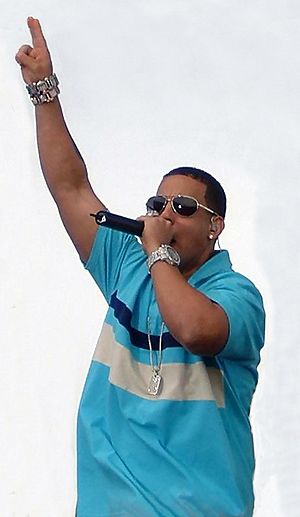Reggaeton facts for kids

Reggaeton is a type of urban music that became popular with young people in Latin America during the early 1990s. It started in Panama as "Reggae en Español." Later, it grew and changed in Puerto Rico to become what we now know as reggaeton.
This music mixes sounds from British West reggae and dancehall with Latin American styles. It also includes elements from hip hop music. Most modern reggaeton songs use a beat called the Dem Bow Riddim. This beat was created by Jamaican producers Steely & Clevie in the late 1980s and early 1990s. Over time, reggaeton has changed a lot from its original reggae roots.
Contents
What Does "Reggaeton" Mean?
The word reggaeton comes from "reggae" and the Spanish ending -tón, which means "big" or "large." So, it means "big reggae." This name was first used in 1988 by Michael Ellis, who worked with the artist El General. He used it to describe the music as "reggae grande."
How Reggaeton Started
Reggaeton is a newer music style that began in the late 1980s in Panama. It became very popular thanks to artists from Puerto Rico. At first, it was known as "Rap y reggae underground" music. This was because it was shared through informal ways and played at unofficial places.
DJ Playero and DJ Nelson were inspired by hip hop and Dancehall music. They started making "riddims," which were the first reggaeton tracks. As Caribbean and African-American music grew in Puerto Rico, reggae rap in Spanish became a way for many young people to express themselves.
This music created a hidden but important youth culture. It often faced criticism. For a while, police in Puerto Rico tried to stop this "underground" music. They took cassette tapes from stores and gave fines. But people still found ways to share the music, often through bootleg recordings and by telling others about it.
By 1998, this music officially became modern reggaeton. Its popularity grew even more when people around the world discovered it in the early 2000s.
What Reggaeton Sounds Like
The Dembow Rhythm
The dembow riddim is the main beat in reggaeton. Jamaican dancehall producers created it in the late 1980s and early 1990s. The Dembow beat includes sounds from a kick drum, snare drum, and other percussion instruments.
This rhythm was influenced by dancehall and other West Indian music like soca and calypso. This gives Dembow a unique Caribbean feel. Steely & Clevie are usually given credit for creating the Dembow rhythm. At its core, it has a special 3+3+2 rhythm, with a bass drum beat.
The Dembow rhythm first became famous with Shabba Ranks' song "Dem Bow" in 1991. Even today, parts of this song's beat are found in over 80% of all reggaeton songs. In the mid-1980s, electronic keyboards and drum machines changed dancehall music. Producers used them to make many different dancehall rhythms, including Dembow.
Dembow is like a basic building block for reggaeton. It's the simple drum pattern that many songs are built upon. Reggaeton also uses other Jamaican rhythms like Bam Bam and Hot This Year. Sometimes, songs use a lighter, electronic version of the Dembow rhythm. Good examples are "Pa' Que la Pases Bien" and "Quiero Bailar."
Since 2018, a new version of the Dembow rhythm has appeared. Starting with the song Te Bote, a sharper, simpler Dembow has become common. This has allowed for more creative and varied rhythms in reggaeton.
Lyrics and Themes
Reggaeton songs often have a similar structure to hip hop songs. Most reggaeton artists rap their lyrics, or they mix rapping with singing. Reggaeton songs usually have verses, a chorus, and a bridge, just like hip hop.
Like hip hop, reggaeton songs have a catchy part called a hook that repeats throughout the song. A common theme in reggaeton is Latino identity. This is shown in the music, the lyrics, and the videos.
Images for kids
-
J Balvin in 2017
See also
 In Spanish: Reguetón para niños
In Spanish: Reguetón para niños




